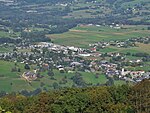Saint-Germain-la-Chambotte
Former communes of SavoiePages with French IPASavoie geography stubs

Saint-Germain-la-Chambotte (French pronunciation: [sɛ̃ ʒɛʁmɛ̃ la ʃɑ̃bɔt]; Arpitan: San-Zharmin) is a former commune in the Savoie department in the Auvergne-Rhône-Alpes region in south-eastern France. On 1 January 2016, it was merged into the new commune of Entrelacs.
Excerpt from the Wikipedia article Saint-Germain-la-Chambotte (License: CC BY-SA 3.0, Authors, Images).Saint-Germain-la-Chambotte
Chemin sur Louche, Chambéry
Geographical coordinates (GPS) Address Nearby Places Show on map
Geographical coordinates (GPS)
| Latitude | Longitude |
|---|---|
| N 45.7792 ° | E 5.8925 ° |
Address
Chemin sur Louche
Chemin sur Louche
73410 Chambéry (Saint-Germain-la-Chambotte)
Auvergne-Rhône-Alpes, France
Open on Google Maps







